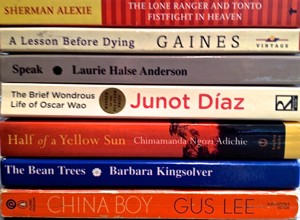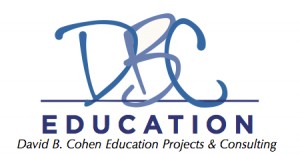When it comes to curricular choices, high school English classes have a vast range of options. Our students may study texts thousands of years old, or texts published online only hours ago. We can study translations from around the world, or turn our energies inwards to create and study our own writing. At times we incorporate fine arts, performing arts, film and other modern media to help develop a theme or illustrate a concept.
 There’s an appealing challenge for teachers in trying to strike the right balance in the design of a course, or the entire scope and sequence of a high school curriculum. We know that our students are well-served if we provide them with some shared exposure to classic texts that form the canon of English and American literature, and we also know that our students deserve a diversity in their reading that may not be reflected in that canon. We value the classics for their place in the foundations of literature, traditions, and history, and we also appreciate the contemporary works which expose and reflect our contemporary experiences and concerns.
There’s an appealing challenge for teachers in trying to strike the right balance in the design of a course, or the entire scope and sequence of a high school curriculum. We know that our students are well-served if we provide them with some shared exposure to classic texts that form the canon of English and American literature, and we also know that our students deserve a diversity in their reading that may not be reflected in that canon. We value the classics for their place in the foundations of literature, traditions, and history, and we also appreciate the contemporary works which expose and reflect our contemporary experiences and concerns.
I also think it’s important to include an element of student choice when I design a course. Each class validates that approach in unique ways, and somehow, I still end up surprised by their reactions and their work relating to literature they’ve chosen to study.
In some courses I teach, I end the year with students studying in small, self-directed groups, and choosing a major work (or pairing of shorter works) to read together. I have about 15 to 20 options I’ve offered in recent years, depending on the grade and course, and I try to “sell” each choice by emphasizing its potential interest and value. There are books written nearly 200 years ago, many from the 20th century, and at least one from the past decade. There are male and female authors, gay and straight, and authors from varying ethnic and cultural backgrounds.
The wonderful thing about offering options to students is that they end up making choices I didn’t anticipate, having reactions I wouldn’t have predicted, and forming insights I hadn’t considered. This year, I’ve been surprised at how many students chose to study The Scarlett Letter. (I’ve had students choose it before, but this year more than in the past). Setting aside the challenges of the writing style and the novel’s pace, these students find the novel quite relevant, wrestling as it does with weighty questions of morality, hypocrisy, revenge, redemption, and privacy in a society that wants to make shame and virtue into public matters. Another group chose Willa Cather’s My Àntonia, the first time I’ve had students choose this novel though I’ve offered it many times. I always tell students how much I love Cather’s writing, but I always concede up front that it’s not necessarily the book to choose if plot and action are important to you. Four of my students thankfully found the same appreciation of Cather’s prose, but then went on to reach varied conclusions about what matters most in the novel, and how it relates to our current thinking about gender and immigration. Another group thought The Grapes of Wrath sounded intriguing; they nearly balked when they saw the physical size of the book, and then decided to go for it, essentially assigning themselves considerably more homework than I would have, and buying into the process because they made the decision independently.
It has also been fascinating to see how students’ reading selections teach me valuable lessons about the connection between reading and identity. We know that it’s important for children to see themselves reflected in literature and to have a broader view of what constitutes “history.” But it turns out that students’ motivations and approaches to reading will vary considerably when they have options. One year, four female students, all friends, from Chinese, Taiwanese, and Japanese family backgrounds, all chose to work together studying Amy Tan’s The Joy Luck Club. Now, I never would have imposed the idea of grouping Asian-American girls together to read a Chinese-American author’s book about Chinese women and their daughters. However, their choice to do so allowed them to leverage their family background to help their studies in my class, and use their studies to actually facilitate some dialogue and new understanding in their own families. I’ve also had an all-female groups choose to study Barbara Kingsolver’s The Bean Trees, a novel largely focused on the importance of female friendships and mutual support.
On the other hand, I’ve had small groups of students frequently choose and enjoy books that offer no apparent personal links in terms of the identity of the authors or characters. I’ve seen groups without any African-American students still take an interest in black authors and achieve great success in studying Ernest Gaines’ novel A Lesson Before Dying, and Octavia Butler’s hybrid of historical fiction and science fiction, Kindred. In the same class, an African-American female student passed on the options of reading African-American female authors, and instead opt to work with a group studying Gus Lee’s China Boy. Then, this year, a male African-American student went with Tennessee Williams and The Glass Menagerie. We can’t assume too much about gender, either, as a female student recently reminded me, indirectly, when she wrote about how closely she identifed with the male protagonist in Ray Bradbury’s Fahrenheit 451.
Reading is personal. When it’s most effective, and most impactful, it works because we readers let authors have our attention, our trust. They occupy some of our mental space for a period of time. With fiction, and sometimes with non-fiction, we journey to other settings, identify with others, as others, sometimes have the sensation of becoming other people. And in fact, when we emerge from the reading, we are different people, possessed of some new knowledge, new curiosity and sympathy.
We owe our students some shared reading experiences in school, a working knowledge of literary traditions and canonical texts. We should also guide them towards a range of reading and learning possibilities in which they have choices and we refrain from excessive control, withholding our predictions about what they should find relevant or meaningful. It’s a balancing act that in itself continually teaches us about out students and our work, and should leave us with a sense of both importance and humility.
Originally posted at my EdWeek Teacher blog, Capturing the Spark, May 30, 2017.
